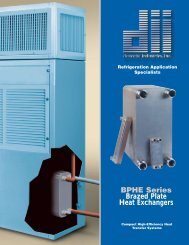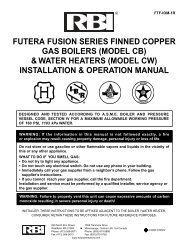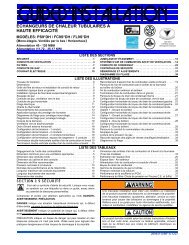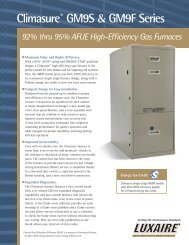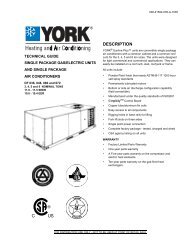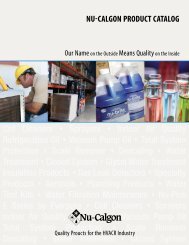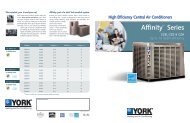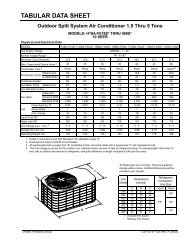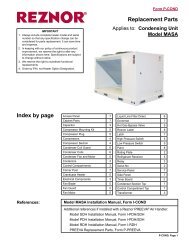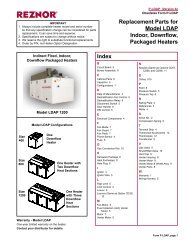Y-IM-Single Package AC and Single Package Gas/Electric Units ...
Y-IM-Single Package AC and Single Package Gas/Electric Units ...
Y-IM-Single Package AC and Single Package Gas/Electric Units ...
You also want an ePaper? Increase the reach of your titles
YUMPU automatically turns print PDFs into web optimized ePapers that Google loves.
127083-Y<strong>IM</strong>-B-0606<br />
(i.e. first stage has energized the economizer), "Y2" will energize<br />
compressor #1. If the outdoor air is above the set point,<br />
"Y2" will energize compressor #2.<br />
Once the thermostat has been satisfied, it will de-energize<br />
“Y1” <strong>and</strong> “Y2”. If the compressors have satisfied their minimum<br />
run times, the compressors <strong>and</strong> condenser fans are deenergized.<br />
Otherwise, the unit operates each cooling system<br />
until the minimum run times for the compressors have been<br />
completed. Upon the final compressor de-energizing, the<br />
blower is stopped following the elapse of the fan off delay for<br />
cooling, <strong>and</strong> the economizer damper goes to the closed position.<br />
If the unit is in continues fan operation, the economizer<br />
damper goes to the minimum position.<br />
ECONOMIZER WITH DUAL ENTHALPY SENSORS -<br />
The operation with the dual enthalpy sensors is identical to<br />
the single sensor except that a second enthalpy sensor is<br />
mounted in the return air. This return air sensor allows the<br />
economizer to choose between outdoor air <strong>and</strong> return air,<br />
whichever has the lowest enthalpy value, to provide maximum<br />
operating efficiency.<br />
ECONOMIZER WITH POWER EXHAUST -<br />
A unit equipped with an economizer (single or dual enthalpy)<br />
<strong>and</strong> a power exhaust operates as specified above with one<br />
addition. The power exhaust motor is energized 45 seconds<br />
after the actuator position exceeds the exhaust fan set point<br />
on the economizer control. When the power exhaust is operating,<br />
the second stage of mechanical cooling will not operate.<br />
As always, the "R" to "G" connection provides minimum<br />
position but does not provide power exhaust operation.<br />
MOTORIZED OUTDOOR AIR DAMPERS -<br />
This system operation is the same as the units with no outdoor<br />
air options with one exception. When the "R" to "G" circuit<br />
is complete, the motorized damper drives open to a<br />
position set by the thumbwheel on the damper motor. When<br />
the "R" to "G" circuit is opened, the damper spring returns<br />
fully closed.<br />
COOLING OPERATION ERRORS<br />
Each cooling system is monitored for operation outside of the<br />
intended parameters. Errors are h<strong>and</strong>led as described below.<br />
All system errors override minimum run times for compressors.<br />
HIGH-PRESSURE L<strong>IM</strong>IT SWITCH<br />
During cooling operation, if a high-pressure limit switch<br />
opens, the UCB will de-energize the associated compressor,<br />
initiate the ASCD (Anti-short cycle delay), <strong>and</strong>, if the other<br />
compressor is idle, stop the condenser fans. If the call for<br />
cooling is still present at the conclusion of the ASCD, the<br />
UCB will re-energize the halted compressor.<br />
Should a high-pressure switch open three times within two<br />
hours of operation, the UCB will lock-out the associated compressor<br />
<strong>and</strong> flash a code (see Table 54). If the other compressor<br />
is inactive, the condenser fans will be de-energized.<br />
LOW-PRESSURE L<strong>IM</strong>IT SWITCH<br />
The low-pressure limit switch is not monitored during the initial<br />
30 seconds of a cooling system's operation. For the following<br />
30 seconds, the UCB will monitor the low-pressure<br />
switch to ensure it closes. If the low-pressure switch fails to<br />
close after the 30-second monitoring phase, the UCB will deenergize<br />
the associated compressor, initiate the ASCD, <strong>and</strong>,<br />
if the other compressor is idle, stop the condenser fans.<br />
Once the low-pressure switch has been proven (closed during<br />
the 30-second monitor period described above), the UCB<br />
will monitor the low-pressure limit switch for any openings. If<br />
the low-pressure switch opens for greater than 5 seconds,<br />
the UCB will de-energize the associated compressor, initiate<br />
the ASCD, <strong>and</strong>, if the other compressor is idle, stop the condenser<br />
fans.<br />
If the call for cooling is still present at the conclusion of the<br />
ASCD, the UCB will re-energize the halted compressor.<br />
Should a low-pressure switch open three times within one<br />
hour of operation, the UCB will lock-out the associated compressor<br />
<strong>and</strong> flash a code (Table 54). If the other compressor<br />
is inactive, the condenser fans will be de-energized.<br />
FREEZESTAT<br />
During cooling operation, if a freezestat opens, the UCB will<br />
de-energize the associated compressor, initiate the ASCD,<br />
<strong>and</strong>, if the other compressor is idle, stop the condenser fans.<br />
If the call for cooling is still present at the conclusion of the<br />
ASCD, the UCB will re-energize the halted compressor.<br />
Should a freezestat open three times within two hours of<br />
operation, the UCB will lock-out the associated compressor<br />
<strong>and</strong> flash a code (Table 54). If the other compressor is inactive,<br />
the condenser fans will be de-energized.<br />
LOW AMBIENT COOLING<br />
To determine when to operate in low ambient mode, the UCB<br />
has a pair of terminals connected to a temperature-activated<br />
switch set at 45ºF. When the low ambient switch is closed<br />
<strong>and</strong> the thermostat is calling for cooling, the UCB will operate<br />
in the low ambient mode.<br />
Low ambient mode operates the compressors in this manner:<br />
10 minutes on, 5 minutes off. The indoor blower is operated<br />
throughout the cycle. The 5-minute off period is necessary to<br />
defrost the indoor coil.<br />
Low ambient mode always begins with compressor operation.<br />
Compressor minimum run time may extend the minutes<br />
Unitary Products Group 49



